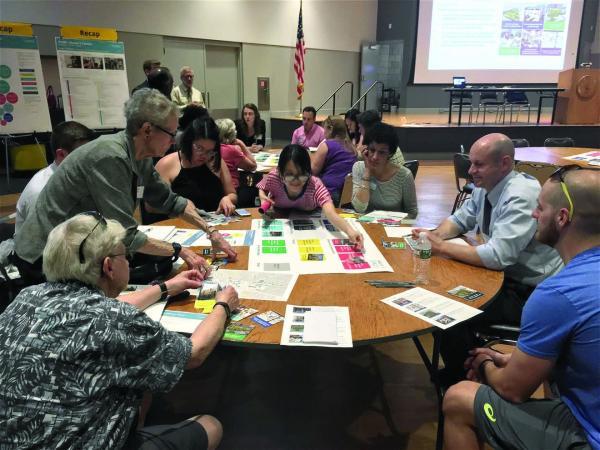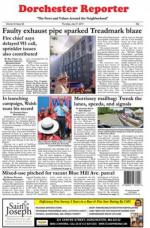May 25, 2017

A group of participants at a Glover’s Corner visioning session place their top planning priorities on a table. Jennifer Smith photo
Glover’s Corner ‘visioning’ keys in on affordability
How best to preserve neighborhood diversity and housing equity while also accommodating ongoing and much-needed growth consumed the conversation at a Glover’s Corner visioning session last week.
The meeting was organized by the Boston Planning and Development Agency (BPDA), which is conducting a study for development in the area. On a balmy May evening, about 30 residents moved about the IBEW union hall on Freeport Street, where they were joined by a cadre of BPDA officials.
Covering 86.3 acres between Savin Hill and Fields Corner, the “PLAN: Glover’s Corner” incorporates mixes of industrial, commercial, and residential space around a 0.8-mile Dorchester Avenue spine. The initiative started in earnest about two months ago, with a question campaign, an open house, and a walking tour.
Planning is not the same as development, BPDA officials noted. “Planning doesn’t build anything,” said project manager Viktorija Abolina. “So what we do is look at how can we guide growth in a way that’s fair and equitable for existing residents and for future residents.”
Residents were asked to select three priorities from a deck of cards containing topics such as housing, commercial space, and transit, among others. Attendees were broken into small groups to consider why their cards were selected and then report to the broader gathering on issues that rose to the top in their discussions.
Longtime neighborhood organizers Davida Andelman and Janet Jones balked at selecting just three cards, but Lara Mérida, BPDA deputy director for community planning, later explained, “It’s not about the number, it’s about the challenge and the ratio. So, having to think about how the city has to make recommendations of what has to go forward … is a really tough exercise; people get really upset about it, but there’s only a certain amount of land and there’s only a certain amount of funding that can go into it.”
Mérida added that whatever theme arises from this exercise will set the agenda for a future meeting.
Andelman was one of many raising the spectre of displacement. “I think it’s critical that any housing that might come up through this project, we need it to be accessed by people who already live here, and also affordable, because Dorchester is quickly becoming gentrified,” she said.
Of the 1,612 households living in the study area, 78 percent of them pay rent, according to census data. A city analysis of rental prices between 2015 and 2016 found that the Uphams Corner/Savin Hill are saw a dramatic 21 percent drop in rental prices for one-bedroom housing stock built before 2011.
Dorchester and the city as a whole have seen a rental-price drop this past year, with the average rent across apartment types in the Uphams Corner/Savin Hill neighborhood now at about $1,600, and $2,040 citywide.
Participants in all of the groups said preserving diversity is a top priority for the area. Residents in the study area speak Asian languages at a much higher rate than in the rest of the city – 45 percent as compared to 7 percent across Boston. This is in keeping with the demographics of the community, which has an Asian residency of 38 percent, far more than Dorchester (11 percent) and the city as a whole (9 percent).
“People flock here even if you don’t live here,” one participant said. She described the extended commute it takes residents from elsewhere in the city to use public transit to get into the area. “Every Vietnamese person in Boston comes to Glover’s Corner,” she said.
The groups agreed that that diversity and local-first approach should be represented on a business level.
“I would say ‘eh’ to any chains,” one woman said. “Because one of the things that this place has going for it is mom and pop operations. You get to know the owner of the place. You walk in and he’ll say, “Okay, set up the soup, here she is.” Which, again, is part of a community thing.”
Her table said their top priority was to “preserve housing affordability in order to maintain the diversity of our neighborhoods, to keep the people who are there, there,” resident Mike Prokosch summarized as the meeting came to a close.
Participants also noted that most of the priority areas were inter-related. To support diverse businesses, Prokosch said, discussions came up around access to flexible transit options “to supplement walking, and to get people to places where they will then walk and sponsor local businesses.”
Mérida said the planning study was progressing well, but attendance may have been curbed by the recent nice weather. At his canvassing launch in Uphams Corner on Saturday, Mayor Martin Walsh echoed the assessment: “It’s going good,” he said, standing in front of the Strand Theater. “It’s tough right now; it’s the time of year. You know, we had a long winter and kind of a prolonged spring that wasn’t really a spring, and I think people see this type of weather and they don’t want to come out. Or they want to go out but they don’t want to go into a meeting. It’ll go through the summer, and probably the end of the summer. The fall’s the time to really focus on it.”
Villages:
Topics:



